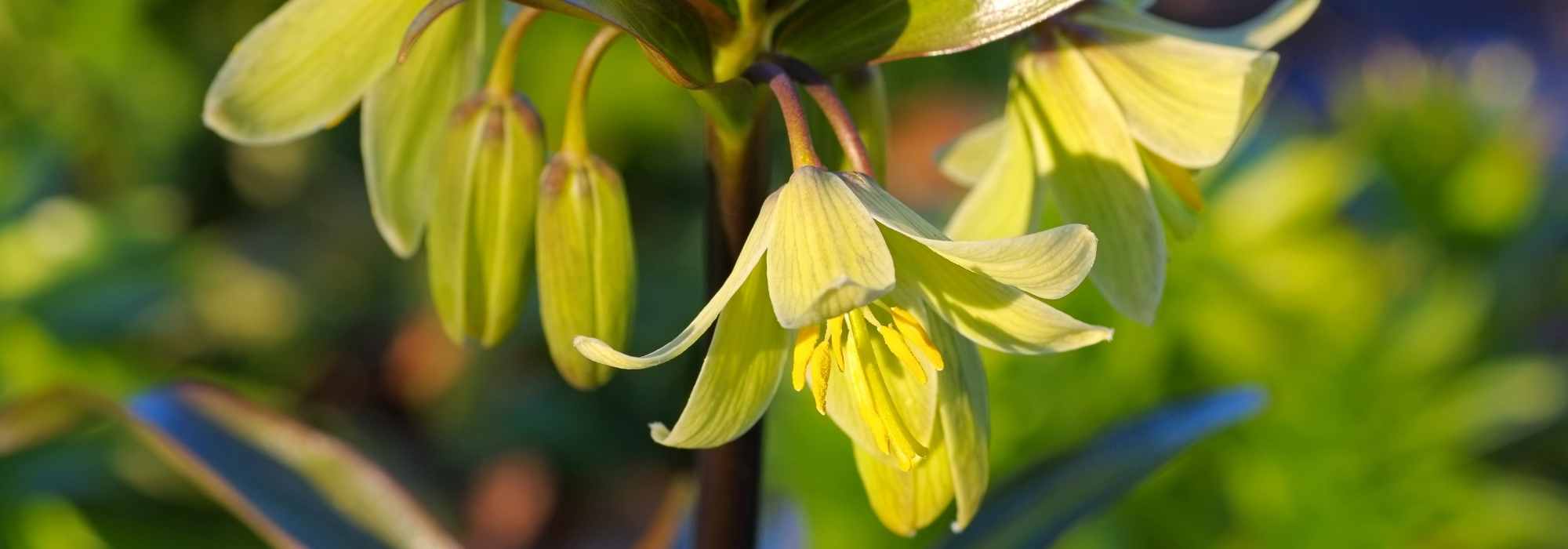
Botanical fritillaries
Discovering graceful and rare fritillaries
Contents
The fritillaries beautifully painted by Redouté are among those bulbous plants that are instantly recognisable with their majestic crown of yellow or orange flowers, proudly standing on a tall stem. While the sculptural imperial fritillary is primarily found in public or private gardens during spring, a few others are worth noting, being less imposing, much more graceful, and discreet, playing on their charm and simplicity. These botanical fritillaries are perfect for adding elegance to romantic or naturalistic gardens.
Here are some of these beautiful, rare, and unusual fritillaries to invite into your garden!
Fritillaria meleagris: meadow
Known by its Latin name Fritillaria meleagris, the snake’s head fritillary is certainly the most well-known after the imperial crown. However, it is radically different, much smaller in size (30 to 40 cm tall) and far more discreet… although easily recognisable by its beautifully spotted bell-shaped flowers with a checkered pattern on all the petals (actually tepals). Ranging in colour from pinkish-purple to wine-red, shaded with cream created by the original checkered pattern, the snake’s head fritillary produces its small drooping bells (3 to 4 cm) often solitary, sometimes grouped in pairs, between mid-March and mid-April depending on the region. The very fine linear leaves are slightly glaucous (bluish) and are arranged along the stem.
This fritillary is native to northern Europe and central Europe, where it naturally grows in fallow land, fresh meadows, at the forest edge, and often along waterways (it is also known as the marsh tulip). It is a rare species protected in its natural habitat. Its vegetative growth is slow; it naturalises, but one must be patient with it and allow its bulb to regenerate!
Plant it in full sun or partial shade, in groups on a lawn for a lovely spring effect, or at the edge of a flowerbed alongside some simple bulbs like snowflakes, or ‘Peeping Jenny’ daffodils and pure white tulips like ‘White Marvel’ in a cool spot in the garden, where it will find the ideal conditions for its development.
N.B.: Fritillaria latifolia, native to the Caucasus and Turkey, resembles it but is smaller.

Fritillaria meleagris
Fritillaria pontica: bicoloured and graceful
Originating from South-eastern Europe and Turkey, the Fritillaria pontica features beautiful narrow, slightly greyish green foliage, located at the upper part of the stem, forming a lovely green tuft just below the inflorescence. The flowers, irregularly yellowish-green with brownish-purple wash, appear in April or May. They take the form of charming pendulous bells measuring 3 to 4 cm, either solitary or grouped in clusters of 2 or 3 flowers, blooming from April to June depending on the region. Of medium height, the Fritillaria pontica measures between 25 and 40 cm tall.
Very hardy, it is one of the easiest to grow among the botanical fritillaries, alongside the guinea fowl fritillary. It should be planted in partial shade, in particularly well-drained soil. However, it suffers during heatwaves and is sensitive to drought, so avoid it in the hottest regions of the country; it will thrive in montane areas.
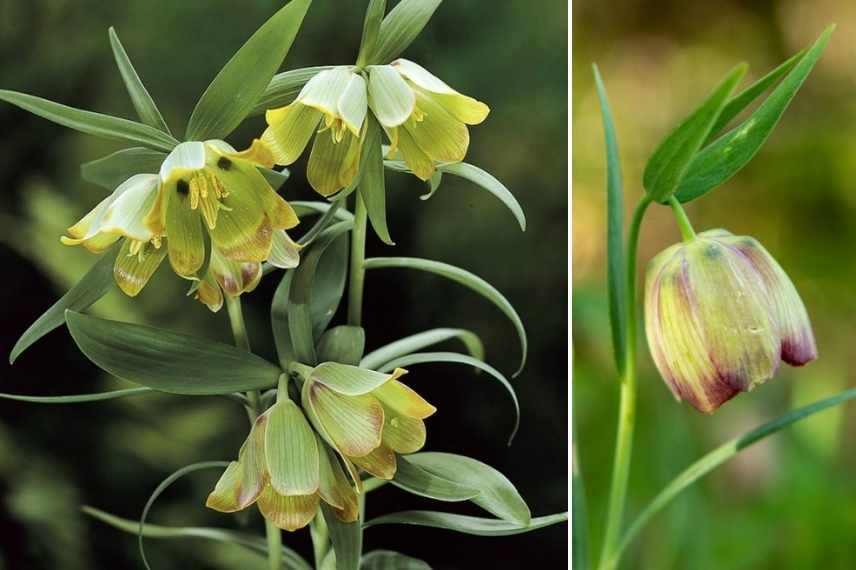
Fritillaria pontica
Discover other Fritillaria
View all →Available in 2 sizes
Available in 0 sizes
Available in 0 sizes
Available in 1 sizes
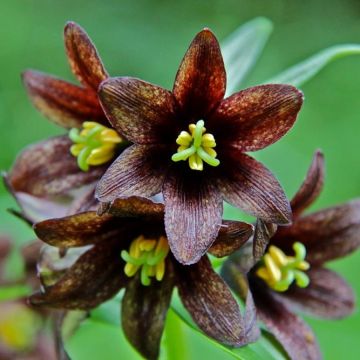
Available in 1 sizes
Available in 1 sizes
Available in 1 sizes
Available in 1 sizes
Available in 1 sizes
Available in 1 sizes
Fritillaria persica: dark and sublime
Here is a sumptuous fritillary that should captivate you if you love dark-hued flowers. Fritillaria persica hails from southern Turkey, and it is a rock garden species that requires plenty of sunlight to thrive. Different from other botanical fritillaries due to its impressive stature—up to 1 m in its natural habitat—it boasts long stems measuring 70 cm to 90 cm high, adorned with narrow, whorled, bluish leaves and a beautiful floral spike bearing around twenty trailing, purple, almost black flowers. Flowering occurs in April or May. This fritillary can even grow in arid and desert-like soil in the western United States. It is relatively easy to cultivate, provided you respect the conditions of sandy, well-draining, even dry soil, and you will succeed by planting its bulbs in full sun.
Pair the Persian Fritillary with light pink tones such as the large ‘Mango Charm’ tulips, with a peony in a sunny border, or with all the cream-coloured blooms like daffodils, or for a tangy contrast with an Euphorbia characias. A more dynamic scene could incorporate frilly ‘Irene Parrot’ parrot tulips or ‘Juan’ fosteriana tulips, whose marbled purple foliage will elegantly echo the flowers.
Many cultivars have been developed from the type species: Fritillaria persica ‘Adiyaman’ and ‘Twin Towers Tribute’ are among the most beautiful.
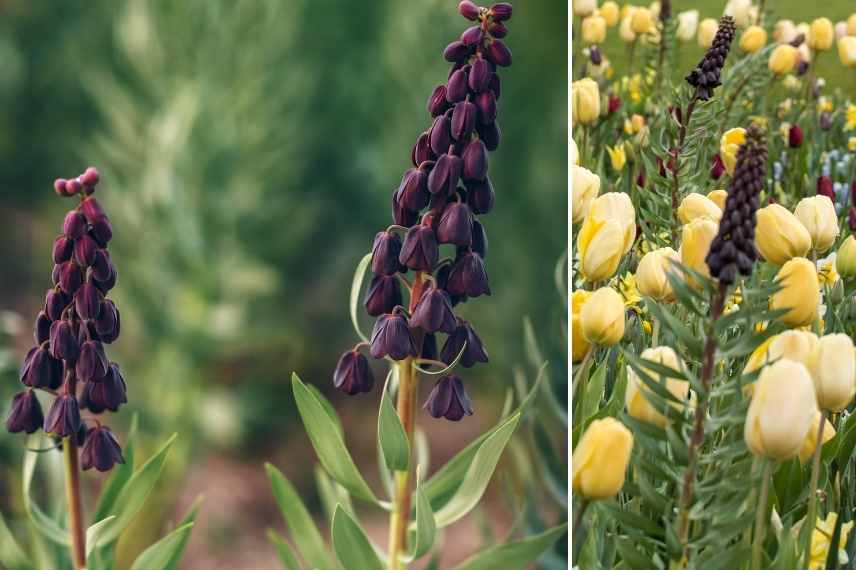
Fritillaria persica
Fritillaria pallidiflora: radiant and floriferous
Here is one of the most charming botanical fritillaries… it hails from the polar cold of Siberia and grows naturally at altitudes of up to 2000 m. The Fritillaria pallidiflora, or pale-flowered fritillary, measures 30 to 50 cm in height, featuring a thick stem and beautiful grey-silver leaves, lanceolate in the upper part and broad for a fritillary. The flowering varies between a very soft yellow and an anise green, appearing in April, formed by bells measuring 3 to 4 cm. Gathered in a bouquet, there can be up to 8 on each plant, clustered in the upper axil of the leaves. Completely hardy and relatively easy to cultivate, this elegant fritillary requires a sunny position or light shade to flower abundantly, and a soil that remains consistently cool but well-drained. Slow to establish, expect two to three good years before it flowers profusely.
The Fritillaria pallidiflora will look stunning in a naturalistic garden alongside a few simple tulips, Iris reticulata, or a carpet of muscari or Anemone Blanda ‘Blue Shades’, and in a yellow garden with a mass of more vibrant yellow daffodils, such as the ‘Camelot’ daffodil.
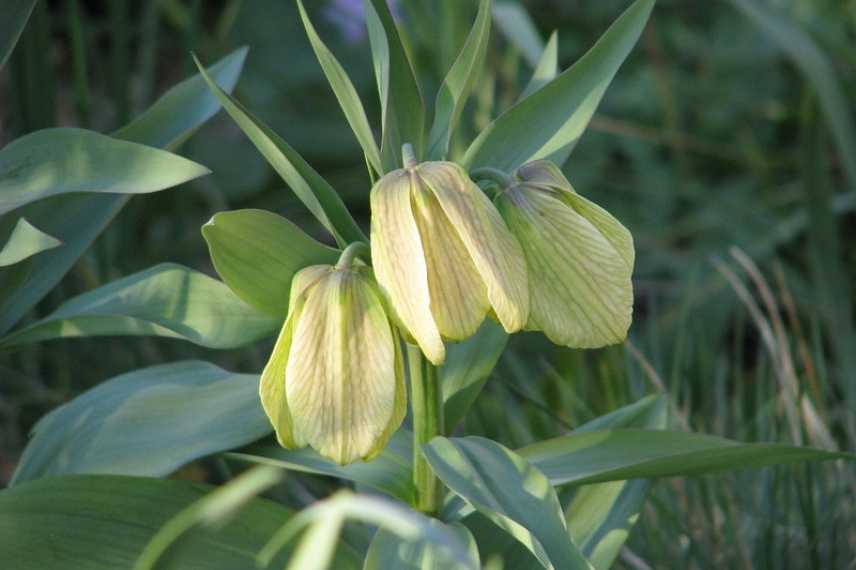
Fritillaria pallidiflora (© Peganum)
Fritillaria bucharica: refined for rock gardens
The Fritillary bucharica is somewhat different from those in this selection for several reasons. Firstly, it produces a large quantity of flowers grouped in clusters on each stem early in spring, as early as March or April, in a beautiful pure white colour, accented by a green throat and the bright yellow of the stamens. These are star-shaped, clearly visible, and gradually droop as flowering progresses. Perfectly hardy, native to Central Asia and Afghanistan, it is a small fritillary in size, measuring between 10 cm and 35 cm at most. It grows in its native habitat on rocky slopes, up to 2000 m in altitude. Therefore, it requires a very well-drained soil and should benefit from good sunlight to thrive. Cultivate it in a pot if you do not have these conditions.

Fritillaria bucharica
Fritillaria liliacea: delicate
The Fritillaria liliacea is a lovely fritillary, endemic to California, where it is becoming rare, but it is no longer endangered. Small in size, about 35 cm, this pretty fritillary blooms between February and April. It bears pendulous white bell-shaped flowers, striped with green. Sometimes referred to as the fragrant fritillary, it may be slightly scented. It prefers sunny locations and cool, ideally clayey soils that remain dry in summer. This fritillary is a bit more tender than others, hardy down to -6.5 °C. It is easier to grow in a pot if your soil is not suitable.
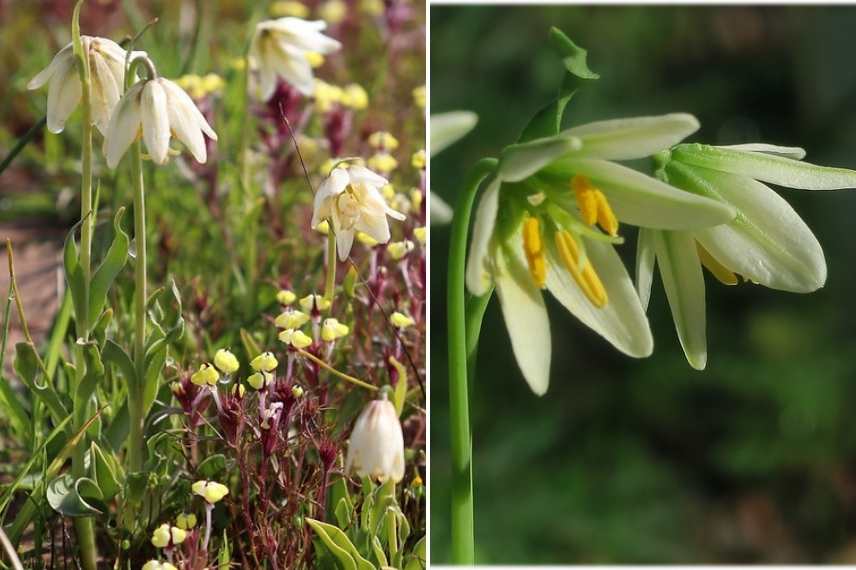
Fritillaria liliacea (© Vahe Martirosyan) and close-up of the flower (© John Rusk)
Fritillaria camschatcensis: for wet soils
Native to the wetlands of Japan and North America, Fritillaria camschatcensis (or Kamchatka Lily) is somewhat unique among fritillaries, and like its counterpart Fritillaria meleagris, which grows in woodlands, it prefers cool to very moist soil.
This is a rarity, an atypical fritillary that also blooms later than its relatives, in late spring, from June to mid-July. The delicate flowers are a beautiful, bright purple, often speckled with yellow, enhanced by golden yellow stamens. The widely opened petals will also droop like most fritillaries. The Kamchatka fritillary remains of medium height, about 40 cm tall, but can bear up to 6 flowers per stem. The fine green foliage is arranged in whorls on a very upright and sturdy stem. Once established, it will gradually spread and naturalise. This Kamchatka fritillary is suited for enthusiasts or collectors, as it is somewhat more challenging to cultivate, thriving in cool, well-drained, humus-bearing, slightly acidic, and partially shaded soil.
Pair it with some ferns like Cyrtomium falcatum, hostas, and some pink astilbes like Astilbe simplicifolia ‘Pink Lightning’, which has a lovely light salmon pink, or Trollius pumilus in golden hues. Also, try an astonishing combination with Arisaema concinnum, the green and purple cobra plant!
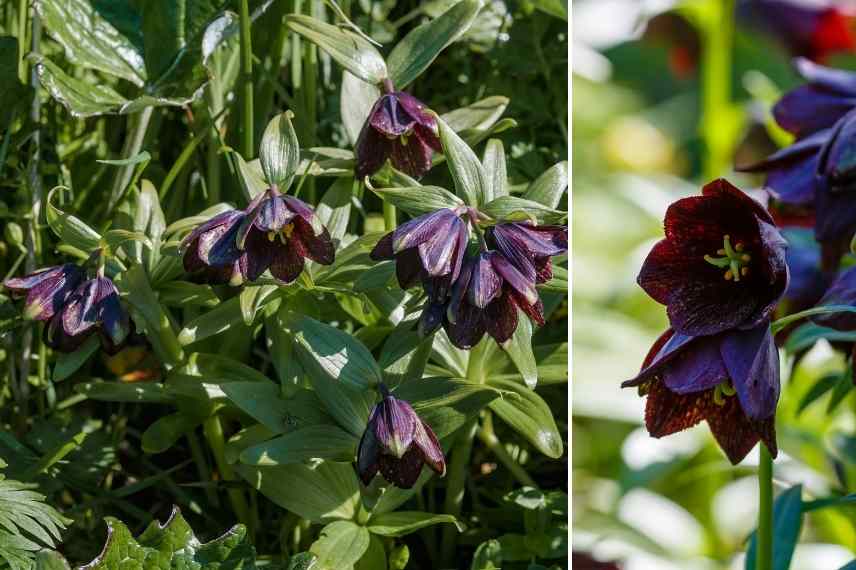
Fritillaria camschatcensis
About Botanical Fritillaries
It is important to know that many botanical fritillaries are difficult to cultivate in gardens; they are considered collector’s plants. The species we mention in this article are the easiest to succeed with, but they remain rare, so recreate their growing conditions to avoid failures. As we have seen, botanical fritillaries need to be planted either in moist soil or, conversely, in dry, well-drained, almost rocky soil, remaining dry in summer, as with the Persian Fritillary. Therefore, you must be vigilant about their growing requirements, as neglecting them could lead to issues if your soil does not meet their needs.
We also recommend adhering to their climatic conditions and hardiness, as these can vary. In any case, it is the winter soil moisture that poses a risk. Additionally, as with imperial fritillaries, be sure not to move them for at least four years after planting, as they are somewhat slow to establish.
Finally, do not collect the species you may find during your walks and hikes, as they are protected.
- Subscribe!
- Contents
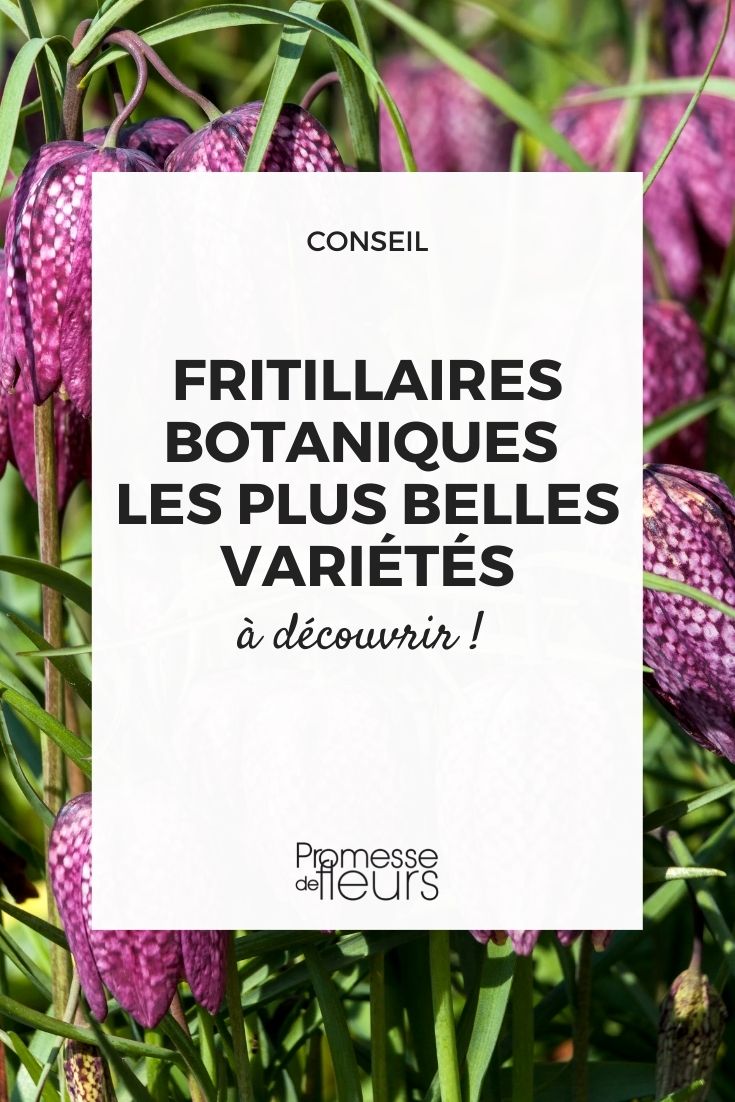
































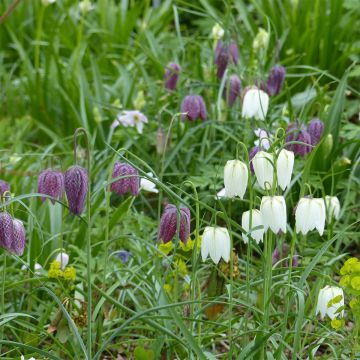



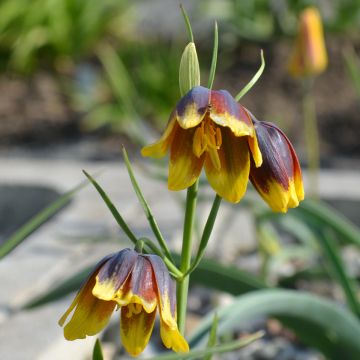
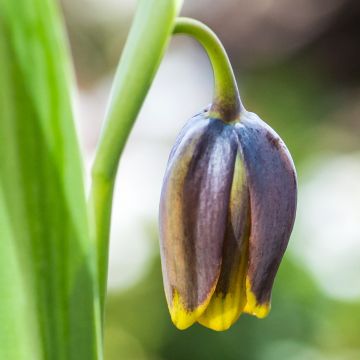

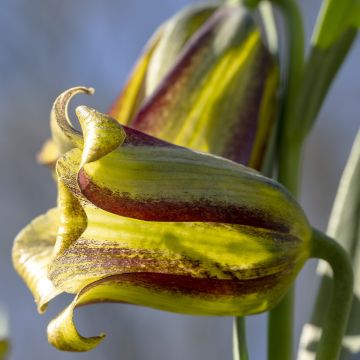
Comments